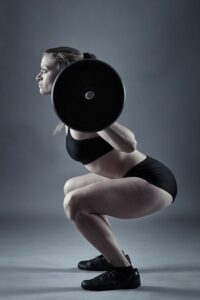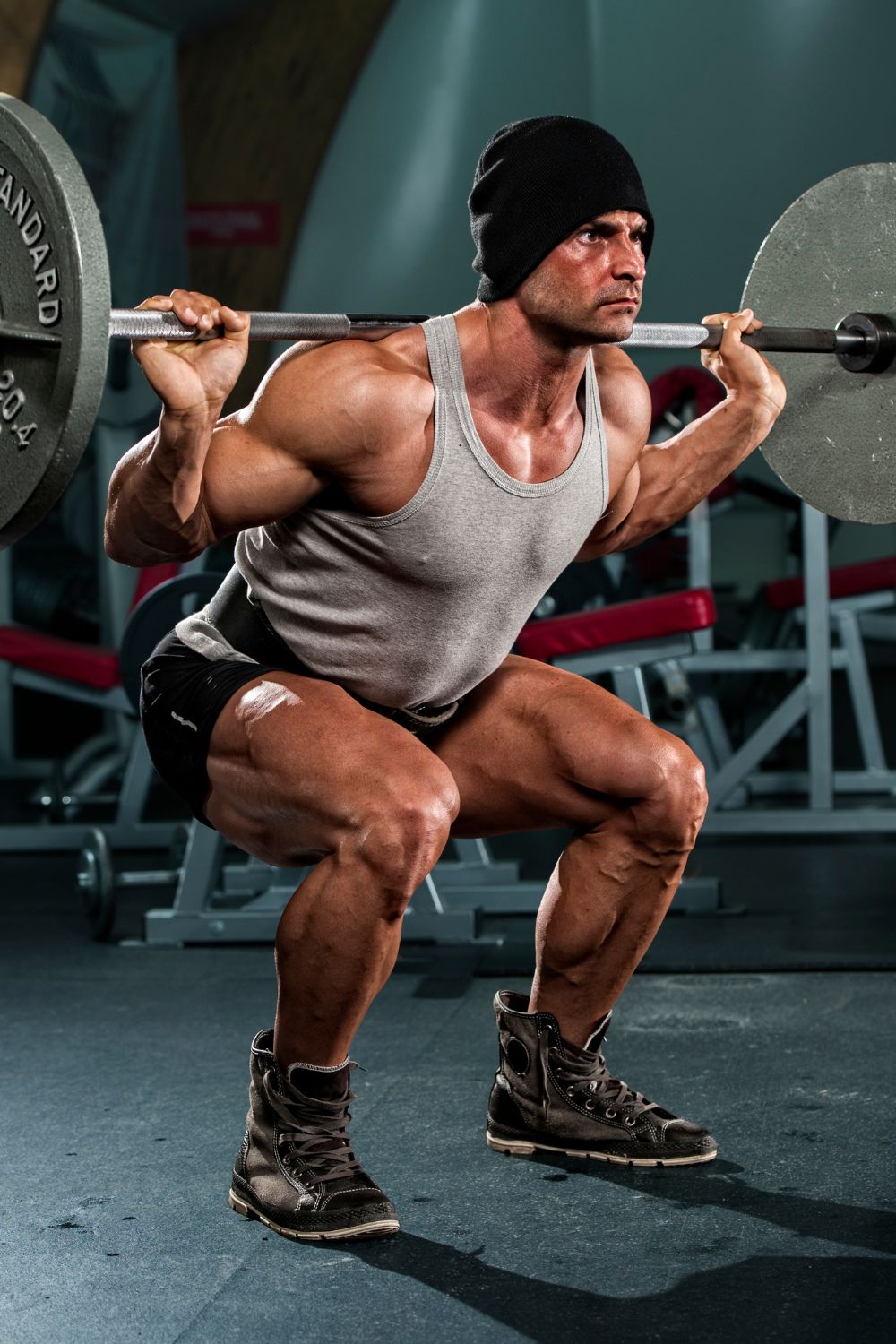The Importance of Squats in Weightlifting
Before we discuss the distribution of front squats and back squats in your training routine, let’s highlight why squats are crucial for weightlifting.
Squats are fundamental for the following reasons:
- Leg Strength: Squats primarily target your quadriceps, hamstrings, and glutes, which are key muscle groups used in weightlifting movements like the clean and jerk and snatch.
- Core Stability: Squats also engage your core muscles, helping you maintain a stable torso during lifts.
- Transfer of Power: The strength gained from squats directly translates to increased power production, enabling you to lift heavier weights.
- Injury Prevention: Strengthening your legs and core through squats can reduce the risk of injury in weightlifting, as it promotes overall stability and balance.
Assessing Your Training Goals
The distribution of front squats and back squats in your training routine should align with your specific training goals. Here are a few common scenarios:

1. Weightlifting Focused
If your primary goal is to excel in weightlifting, with an emphasis on the clean and jerk and snatch, you should allocate more time to front squats. These squats mimic the receiving position in the clean and jerk and snatch, making them highly specific to the demands of these lifts. In this case, a ratio of approximately 2-3 front squat days for every 1-2 back squat days is a common approach.
2. General Leg Strength
If you’re looking to improve leg strength for overall athletic performance or bodybuilding, a more balanced approach can be effective. You may allocate equal time to front squats and back squats or slightly favor back squats. This approach provides a well-rounded leg development.
3. Rehabilitation and Injury Prevention
In cases where you’re recovering from an injury or prioritizing injury prevention, the distribution should be guided by your physical therapist or trainer’s recommendations. They may recommend more front squats if you need to focus on specific muscle groups or back squats to ensure overall leg strength.
Balancing Front Squats and Back Squats
To achieve a balanced approach to leg strength, we’ll provide a sample training schedule. Remember that your individualized program may vary depending on your specific needs and abilities.
Sample Training Schedule:
Week 1-4: Building the Foundation
Day 1: Front Squat
- Warm-up sets: 2-3 sets of 5-8 reps with light weight
- Working sets: 4 sets of 5 reps at a challenging weight
- Accessory work (e.g., lunges or leg presses): 2 sets of 8-10 reps
Day 3: Back Squat
- Warm-up sets: 2-3 sets of 5-8 reps with light weight
- Working sets: 4 sets of 5 reps at a challenging weight
- Accessory work (e.g., step-ups or leg curls): 2 sets of 8-10 reps
Day 5: Front Squat
- Warm-up sets: 2-3 sets of 5-8 reps with light weight
- Working sets: 4 sets of 5 reps at a challenging weight
- Accessory work (e.g., Bulgarian split squats or Romanian deadlifts): 2 sets of 8-10 reps
Week 5-8: Progressive Overload
Day 1: Front Squat
- Warm-up sets: 2-3 sets of 5-8 reps with light weight
- Working sets: 4-5 sets of 5 reps at an increased weight
- Accessory work (e.g., leg extensions or calf raises): 2 sets of 8-10 reps
Day 3: Back Squat
- Warm-up sets: 2-3 sets of 5-8 reps with light weight
- Working sets: 4-5 sets of 5 reps at an increased weight
- Accessory work (e.g., seated leg curls or planks): 2 sets of 8-10 reps
Day 5: Front Squat
- Warm-up sets: 2-3 sets of 5-8 reps with light weight
- Working sets: 4-5 sets of 5 reps at an increased weight
- Accessory work (e.g., box jumps or glute bridges): 2 sets of 8-10 reps
This sample schedule provides a structured way to balance front squats and back squats, with a gradual increase in intensity. It’s essential to focus on form and maintain proper technique throughout your training.
Progressive Overload and Recovery
No matter the distribution of front squats and back squats, progressive overload is key to continuous improvement. This means gradually increasing the weight you lift over time. It’s important to listen to your body and avoid overtraining, which can lead to injuries or decreased performance. Adequate recovery between training sessions is crucial.
Here are some tips for effective recovery:
- Rest Days: Incorporate rest days into your training routine to allow your muscles to recover.
- Nutrition: Consume a well-balanced diet with sufficient protein to support muscle recovery and growth.
- Sleep: Aim for 7-9 hours of quality sleep per night to aid in recovery.
- Stretching and Mobility: Include stretching and mobility exercises to prevent muscle tightness and imbalances.
- Hydration: Stay adequately hydrated to support overall health and muscle function.
- Periodization: Consider using periodization techniques in your training, which involve varying the intensity and volume of your workouts to prevent plateaus and overuse injuries.
- Listen to Your Body: If you experience pain or discomfort beyond regular muscle soreness, consult with a healthcare professional or a certified trainer.
Monitoring Progress
To ensure you’re making progress in your leg strength, consider the following ways to monitor your training:
- Keep a Training Log: Record your workouts, including the weights used, sets, and reps. This will help you track your progress and make informed adjustments.
- Regular Assessments: Periodically assess your one-rep max (1RM) for both front squats and back squats. This will provide concrete evidence of your strength gains.
- Form Check: Have a coach or experienced trainer evaluate your squat form to ensure you’re lifting safely and efficiently.
- Functional Testing: Assess how your improved leg strength translates to your weightlifting performance by monitoring your clean and jerk and snatch progress.
Conclusion
Front squats and back squats are essential components of a well-rounded weightlifting training program. The distribution between these two squat variations should align with your specific training goals. Remember, there’s no one-size-fits-all answer, and individualized training plans are often the most effective.
By incorporating front squats and back squats into your routine while focusing on progressive overload and recovery, you can enhance your leg strength and overall weightlifting performance. Always prioritize safety and listen to your body, as injury prevention is just as important as strength development in the long run.
So, whether you’re a weightlifting enthusiast, an athlete seeking improved leg strength, or someone recovering from an injury, the balance between front squats and back squats in your training routine can be tailored to your unique needs. As you continue to train and progress, you’ll unlock new levels of strength and performance in the clean and jerk and snatch.
| Aspect | Front Squats | Back Squats |
|---|---|---|
| Primary Target Muscles | Quadriceps, Core, Upper Back | Quadriceps, Hamstrings, Glutes, Core |
| Specificity to Weightlifting | Highly specific to the clean and jerk and snatch due to the front rack position | Less specific but still beneficial for weightlifting as it targets key leg muscles |
| Weight Placement | Barbell rests on the front of shoulders | Barbell rests on the upper back |
| Torso Position | More upright posture, challenging core stability | Slightly more forward lean, engaging lower back more |
| Training Focus | Emphasizes leg strength and core stability | Focused on leg strength, lower back, and glute development |
| Exercise Variation | Various front squat grips (clean grip, cross grip, straps) | Limited variation in bar placement |
| Injury Potential | Lower risk of lower back strain but may strain wrists and elbows | Requires good form to avoid lower back strain |
| Use in Rehabilitation | Useful for knee and quad rehab due to reduced lower back strain | May need modification for rehab due to back engagement |
| Periodization | Easier to change loading parameters due to specificity | Changes in loading may affect other muscle groups |
| Overall Inclusion | More front squat days for weightlifting specificity | Balanced inclusion for general leg strength |
| Progressive Overload | Gradual weight increase is common | Allows for greater weight progression |
| Common Sets and Reps | 4-5 sets of 5 reps with a focus on form | 4-5 sets of 5 reps with attention to back health |
| Accessory Exercises | Often includes exercises targeting the core and upper back | Includes exercises targeting hamstrings and lower back |
| Safety and Technique | Requires proper wrist and elbow flexibility and form | Requires focus on lower back safety and form |
This table provides a quick reference for weightlifters to understand the distinctions between front squats and back squats and make an informed decision about which one to prioritize based on their training goals and needs.
Final words
In the world of weightlifting, the choice between front squats and back squats is a matter of tailoring your training to meet your specific goals and needs. Both of these squat variations offer unique advantages and play crucial roles in enhancing your leg strength, core stability, and overall weightlifting performance.
Front squats are highly specific to the clean and jerk and snatch, as they mimic the receiving position of these lifts. They engage your quadriceps, core, and upper back, making them an excellent choice for those seeking weightlifting precision.
On the other hand, back squats provide a broader leg strength foundation, targeting not only the quadriceps but also the hamstrings, glutes, and core. They can be modified to suit various training goals and are valuable for overall athletic performance.
Remember that there’s no one-size-fits-all answer when it comes to front squats vs. back squats. The choice should align with your aspirations, whether you’re aiming to excel in weightlifting, improve leg strength for other sports, or prioritize injury prevention and rehabilitation.
Whichever path you choose, focus on progressive overload, maintain proper form, and prioritize recovery. Periodically assess your progress, keep a training log, and seek expert guidance when necessary. Your journey to increased leg strength and weightlifting excellence will be as unique as you are.
In the end, the balance between front squats and back squats in your training routine is a personal choice that should cater to your goals, strengths, and areas of development. Continue to challenge yourself, stay dedicated, and enjoy the rewarding journey of becoming a stronger and more skilled weightlifter.
External Links for Further Reading:
- How to Front Squat with Proper Form – A detailed guide on performing front squats with correct form and technique.

Hey there, it’s Mike Rrsq, the Editor-in-Chief over at Jsquat.com, and I’m absolutely obsessed with all things squat fitness! I’ve been lucky enough to get some serious recognition for my work in this field. With a solid background in the fitness and wellness industry, I’ve been there right from the get-go, helping shape this website into what it is today.
You see, I’m not just the boss around here; I’m also a passionate contributor. I love sharing my insights through my articles, and trust me, they’re not your run-of-the-mill stuff. Each piece I write is a labor of love, filled with my expertise and real-world experience in the fitness universe. So, if you’re into fitness and looking for some inspiration, you’re in the right place!

